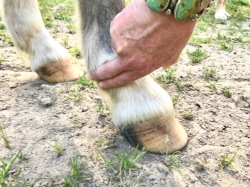Animal Health And Welfare: Laminitis
What do some of us think of when Spring rains bring lush green grass? Laminitis! During the Spring (and Fall), sunny days and cool nights create a surge of sugar in the grass. For horses, ponies, donkeys and even zebras, a fast intake of soluble carbohydrates (sugars and starch) can cause laminitis. So what is laminitis?
Laminitis is the inflammation of the laminae between the hoof wall and the coffin bone. Laminae keeps the coffin, or pedal, bone in place within the hoof. A decrease in the blood flow to the laminae causes it to die and separate, which results in the separation of the hoof wall and the downward rotation of the coffin bone, or founder.
Overweight and cresty-necked animals, as well as easy-keepers and those who have had laminitis in the past are particularly prone to developing laminitis. Stress (due to traveling or foaling), severe infection (from chronic diarrhea or a bad colic attack) and working your horse for long periods on hard ground can also contribute to the development of laminitis.
So what does a laminitic horse look like? How might your horse express pain from laminitis? Your horse might have ‘sore feet’ and rock his weight onto his hind end, as laminitis typically occurs in the front hooves. A reluctance to move and more time lying down could indicate laminitis. Your horse might have a shortened gait that gets worse with more exercise, especially on hard ground. You might see rings that ‘ripple’ down your horse’s hoof wall, starting at the coronary band.
Laminitic horses have an increased, or bounding, digital pulse in their hoof. When I was a Veterinary Technician II in the Large Animal Teaching Hospital at the University of Georgia, part of my equine patients’ hourly examinations included checking their digital pulses, and gauging them from 1-5.
When taking pulses, you are feeling the blood flowing through the artery going into the hooves. If there is inflammation in the hoof, the blood flow is restricted and the artery is backed-up. More inflammation creates a stronger pulse. Difficulty in even detecting a digital pulse can be a good sign- if there is a bounding pulse, there is inflammation and probably pain. If you feel a bounding pulse, take your horse off grass immediately and call your vet.






